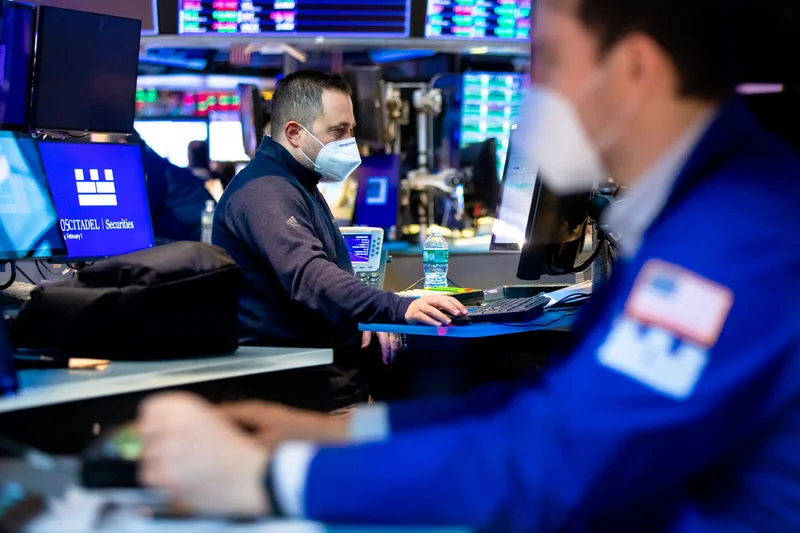The Nasdaq Composite just sliced through 23,000 for the first time. The S&P 500 is shaking off losses to resume its own record-setting climb. On the surface, the numbers paint a picture of unbridled optimism, a market marching confidently into the future, powered by the seemingly limitless potential of artificial intelligence.
But if you turn down the volume on the celebratory cable news chatter and look at the other dials on the dashboard, the readings are erratic, even contradictory. This isn't a healthy, broad-based roar of an engine. It sounds more like a high-pitched whine from one part of the machine while another is sputtering and backfiring. The market is telling two completely different stories at the same time, and simple logic dictates that both of them can’t be true.
The Fed's Blind Navigation
The catalyst for Wednesday’s surge was, as is often the case, the release of the Federal Reserve's meeting minutes. The market’s algo-readers seized on the key phrase: “most judged that it likely would be appropriate to ease policy further.” Rate cuts are coming. The punch bowl isn’t being taken away. Cue the rally.
But reading the full text reveals a committee plagued by what the minutes themselves call "steep divisions." This isn't a confident, unified body guiding the economy with a steady hand. It’s a fractured group with a "range of views" on everything from how restrictive policy currently is to where it should go next. They’re signaling cuts, yes, but with a palpable lack of conviction.
And this is the part of the report that I find genuinely puzzling: they're making these forward-looking pronouncements while flying almost completely blind. The ongoing government shutdown, now a week old, has turned off the spigot of crucial economic data. The very inputs the Fed needs to shape its thinking—jobless claims, inflation reports, retail sales—are simply not there. How can policymakers accurately gauge the economy's trajectory when they're staring at a blank screen? The answer is they can’t. They are steering a multi-trillion-dollar economy by looking at last month's wake.
This data vacuum breeds a dangerous kind of uncertainty. It forces investors and central bankers alike to substitute narrative for numbers. And right now, the most seductive narrative is AI.

A Bifurcated Reality
While the Nasdaq screams higher on the back of names like AMD and Micron, a significant portion of capital is making a frantic dash in the opposite direction. Gold futures just topped $4,000 an ounce for the first time in history. This isn't a modest uptick; it's a massive, record-breaking surge into a haven asset. A move of this magnitude is a vote of no confidence. It’s a "debasement trade" against the dollar, a hedge against the very systemic instability that the equity rally pretends doesn't exist.
Watching gold and the Nasdaq surge in tandem is like seeing a homeowner buy a nine-figure fire insurance policy while simultaneously hosting an indoor fireworks display. It reveals a profound, almost schizophrenic, split in market psychology. One side is betting on a frictionless, technology-driven utopia. The other is betting that the whole system is fragile enough to warrant a flight to the oldest store of value on earth.
This divergence is visible even within the equity market itself. While the Nasdaq Composite jumped over 1%, the Dow Jones Industrial Average (^DJI) lagged, finishing just below the flatline. The rally isn't broad; it's incredibly narrow. The "old economy" stocks that make up the Dow aren't participating in the euphoria. This isn't all ships rising with the tide. It's a handful of tech-fueled speedboats zipping ahead while the heavy cargo ships of the industrial and financial sectors (sectors that actually bucked the trend and ended lower) sit dead in the water.
This brings us to the core of the problem: the AI trade itself. The excitement is palpable, and the spending on infrastructure is real. Professor Jeremy Siegel at Wharton remains "constructive on equities," seeing the "market uptrend intact with AI capex proceeding apace." That’s the bull case in a nutshell. But he also cautions that he’s watching the "tariff test" this quarter. The market is ignoring external risks like trade policy and the shutdown, focusing solely on the AI narrative. When does a powerful growth story morph into a dot-com-style bubble? Are we pricing these companies for perpetual, exponential growth—a mathematical impossibility?
The Data Deficit Is the Real Risk
Let’s be clear. The current market structure is inherently unstable. We have a speculative, narrowly focused tech rally priced for perfection. We have a safe-haven asset hitting all-time highs in a desperate flight from risk. And we have a divided central bank making critical policy decisions based on incomplete, outdated information.
These three conditions cannot logically coexist for long. One of these narratives is wrong. The euphoria in tech stocks is predicated on a stable economic environment with predictable monetary policy—the very things the gold market and the Fed's own internal divisions are screaming we don't have. This isn’t a rally built on a solid foundation of economic fact. It’s a rally built on a story, propped up by the absence of data that might contradict it. The greatest risk to this market isn't a bad inflation print; it's the day the government reopens and the data finally starts flowing again.
